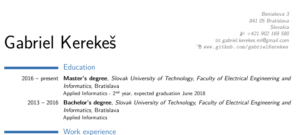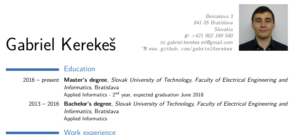Creating a good CV
Resumé, CV, curriculum, lebenslauf. All of these are names for a document, which you send to a company when you are applying for a job there. But you probably know that. What many people don’t know, though, is what is, actually, the purpose of a CV, why they should think their CV through and how a good CV can be created.
Note: If you are just interested in some sample CVs, I have listed some useful links and my personal CV at the bottom of this post.
Why should you even care?
If you really care about getting the job, you should care about your CV. For the job position you have chosen, there is probably more applicants than just yourself. Sometimes there’s so many applicants that the CV reviewer simply doesn’t have the time to go through each CV very thoroughly. This reviewer would probably want your CV to be very concise, short and visually appealing.
But sometimes it might happen, there’s so few applicants that the reviewer will analyze everything in your CV. He/She would probably be glad, if you had included more details in your CV and more personal information. In order to increase your chances of getting through this first step in the hiring process ranked as high as possible, it is best to design your CV in such a way, that it sparks an interest in case of both types of reviewers. In order to be able to design an awesome CV, I think it is important to understand what the actual purpose of a CV is.
What is the purpose of a CV?
The main goal of a CV is to quickly and effectively let the reviewer know who you are, what you have done, how you have done it, what you know and maybe what is there special about you. The reviewer should be able to quickly find these information in your resume. The reviewer should also gain at least a little insight into who you are by reading your CV.
What should you include in a CV?
BASIC INFORMATION
The first thing you certainly need to include in a CV is your basic information. Basic information include your name, age, address of residence (this isn’t maybe necessary anymore), e-mail address and stating your phone number is also a good idea and maybe even a requirement. These information are mostly included in the header of the document (see the sample CVs). For software developers basic information also include some other things. These things are mentioned in the software developer section of this post.
PHOTO
If you feel comfortable having a photo of yourself on the CV, then I certainly recommend putting it there. It makes the CV look a bit less empty, more interesting and it lets the reviewer build a better connection to your persona. Also some reviewers require you to have a photo, which means, that if you don’t include it in, you’re automatically out.


EXPERIENCE
After you’ve got your basic information covered, you should put your work experience in there. However, you should include only relevant work experience. If you have no relevant experience you can also put irrelevant experience in, because it might differentiate you from the other candidates.
Each work experience entry should include your job title, the name of the company, what your responsibilities were, what you have learned at that position and perhaps the size of your team and also the duration of employment. It is probably a good idea to sugar-coat your responsibilities a bit, but don’t go too far. Copy and pasting stuff in a spreadsheet just isn’t the same as being an accountant.
One more important thing is, all of the entries should be order chronologically from newest (at the top) to the oldest (at the bottom). This also counts for education entries, mentioned in the next paragraph.
EDUCATION
Stating you education is also a standard practice. Especially during you first years after school when probably you do not have much else to put there.. You can however omit it later. The education section should simply state what is your highest level of education, where you have gained it, what degree it has gained you and when this has happened. If you have been to university, it is probably best not to mention high school, it’ll just take up space on the resume and won’t add any value. If you are still a student with few or no work experience you should consider placing education before work experience, since that is what best defines you at the moment.
LANGUAGES
Including the languages you are able to speak is a standard as well. You simply state the language and the level of your skills: A1, A2, B1, B2, C1, C2. If you have taken a state exam or have any certificate proving your foreign language level, you should also state that. Mentioning your mother tongue is also normal even if it’s obvious.
SKILLS
The skills section contains any skills that are at least a little relevant to the job you are applying for. Skills can be anything. Skill in a certain software. Client communication skills. Soldering. Fast math. 150 kg bench press. Anything. As long as it is related to the job or it will help you in any way. For example if you are software developer the bench press thing isn’t relevant.
EXTRAS
If you have gained any special certifications or courses you should also mention that. If you have gone through something interesting which strongly shaped who you are, you can also mention that, if it is relevant. However, be careful not to state too much unimportant stuff, which would make the CV unnecessarily long.
It is possible that the job listing will contain some other requirements for what your CV should contain, so be sure to check that you have included everything.
Creating a CV
Now that we have gone through the theory we can actually get down to business. How do you actually create a CV. CV is a document (mostly .pdf, .docx). Your best bet is creating the CV in MS Word (or some free alternative – LibreOffice or the Google office Suite) using some template (check below for some examples). If you are a Mac user you can also use Pages, also with a template. You don’t necessarily need to use a template. Using a template increases the chances of your CV looking good, although it also increases your chances of having the same CV as someone else. Whichever way of creating a CV you choose, it is important, that the final document be in a PDF format. It simply looks better than a editable word document.
Using a template
The reason I recommend using a template is that it is much simpler and also there is a good chance that the template was done by a person, who knows what looks good. And it would be a real shame, if your CV was only a simple document with a bunch of text. It doesn’t have to be too fancy. However only a little bit of color can work wonders and make the CV look as if you really really cared. Templates can also be edited to fit your personal style and perhaps also should be, because the visual side of your CV can also be a way of showing the reviewer who you are.
Also making use of headings, titles, bold typeface, cursive and stuff like that also helps to make your CV look a bit better. If you use a template, it will most probably already have all of this setup, so +1 for templates again.
Instead of using a classical editor, you can also choose one of the many websites that enable you to create a CV for free. I don’t think that is a good idea though, because they are too generic and too common. However, if you feel it is good enough for you, feel free to use that too.
If you are a software developer
If you are a software developer or you are in a related or a creative field here are some extra points which might make your CV another bit better. Otherwise feel free to skip this section or also to read on.
Personal website
When I was applying for my first job, I have made myself a personal website. The website didn’t state too much extra information compared to the CV. It did however go into more detail with the personal projects. Creating a cool personal website might take only 4 hours and it gives you an edge compared to applicants without it.
Even though no one might ever visit your website from your CV, they will at least know that you care. If they choose to visit it, they should be able to find pretty much the same information which can be found in the CV + some extra details if possible. You can write more about your previous job experiences or about your side projects. You can also elaborate on your skills. Write more about how you gained them, how proficient you are in them and so on. Don’t be afraid to get creative.
Github
If you are still a student I recommend putting all your school projects on github (or other git repository website). If you have the time, try to make them a bit cleaner (nice to have) and then publish them via your github profile so that people can see the way you code if they feel like doing so. This goes for small personal projects too.
If you are learning a new language or are just playing around with something, publish it on github. This enables the person looking through your resume to take a look directly at the code you produce. The code doesn’t even have to perfect as no code really is. But just having it there is a great way of showing that, once again, you care. It also shows you like programming and that you are experimenting and learning in your free time. Oh, and don’t forget to put a link to your github profile on your resume.
Other links
Other links that you can include in your CV are for example your LinkedIn and StackOverflow (SO) profile. Filling out your LinkedIn profile is a good idea because recruiters will contact you through LinkedIn on their own accord. It is also simply another place where people can find you, contact you and get to know you. If you managed to get some good answers or question on SO and you have gained some reputation, you should definitely include SO in your CV. I don’t think many people actually do this, so this might just increase your chances of getting in a bit more.
Btw. all links should also be made clickable in the document.
Good luck and be sure to double check your CV
There are just two more things I would like to add. Before you decide to send out your CV, please make sure to double check it for any mistakes. I also highly recommend getting a friend to proof read your CV and give you some recommendations for improvement. That was the first thing. The second thing I wanted to add is – Good Luck!
Useful links
Offical MS templates
Google Docs Template Library
Profesia.sk – Create a CV online
Street of Code – Ep. 6 – Práca popri škole (Časť 2.) – Ako si nájsť prácu
Gabriel’s current CV
Jakub’s CV from when he was looking for a new job while at university
